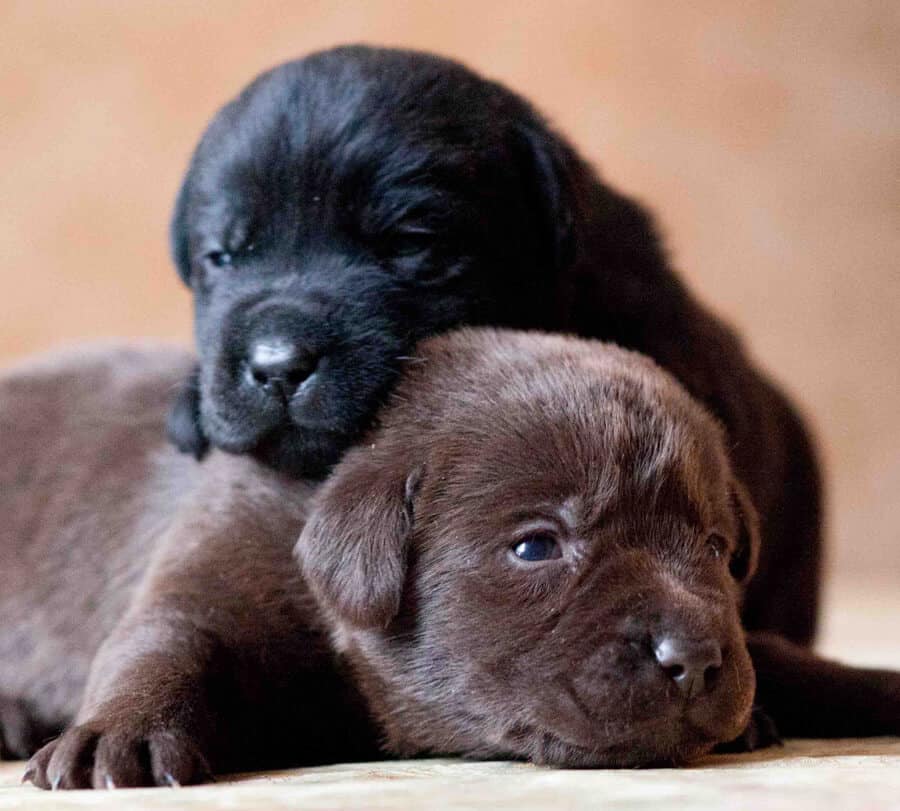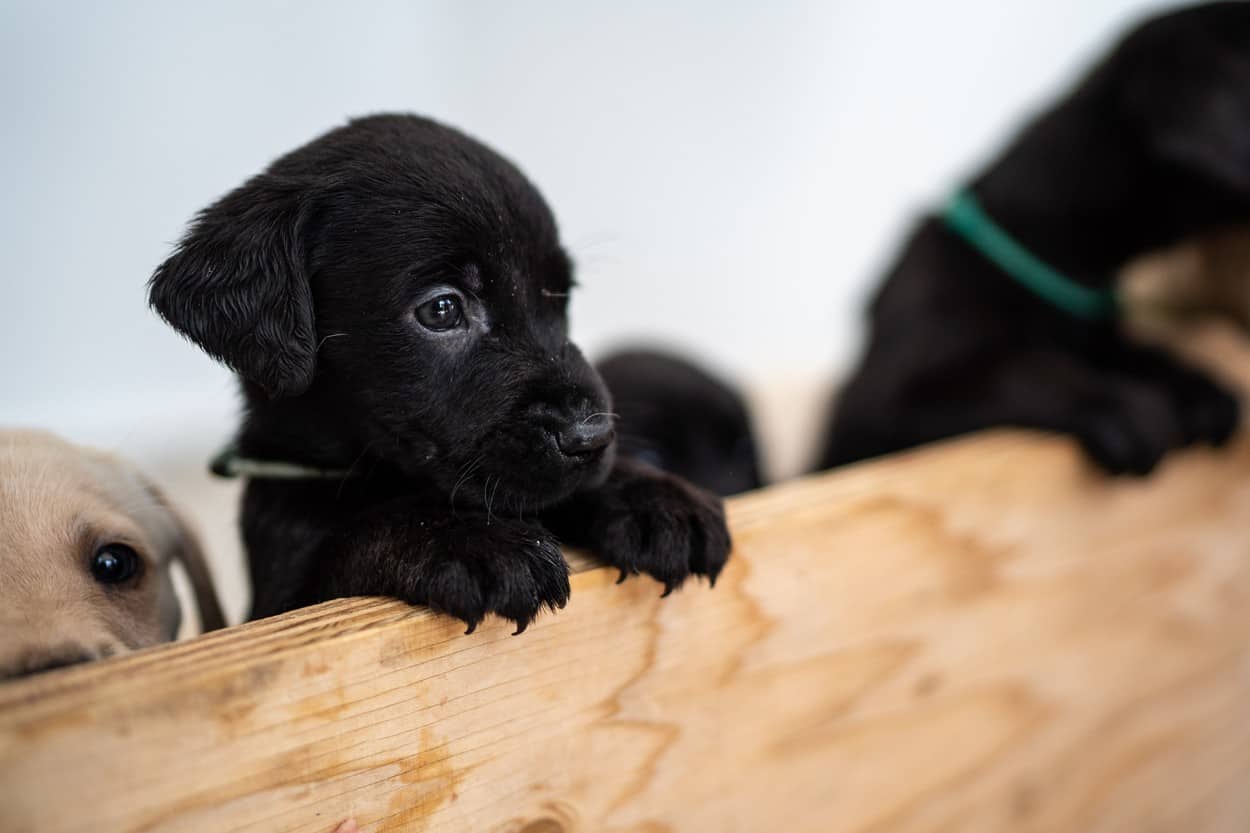Labradors are big dogs, and it’s common for big dogs to have many puppies. But what if you have a Lab that has recently given birth to only 2 puppies? Is that normal for Labradors, or should it be a cause for concern?
It’s normal for a Lab to have only two puppies if it’s her first litter or she’s older than five years old. In general, a Labrador’s litter size is between 5 and 10 puppies. The larger the breed, the more likely the litter will be bigger, but a healthy Lab can also have a small litter.
The rest of this article will go into Labrador litter sizes in greater detail. Keep reading to learn more about this exciting subject!
Why Do Labradors Sometimes Have Small Litters?
A Labrador may sometimes have a small litter because it’s her first one; it’s extremely common for a Labrador’s first litter to be smaller than the following ones. Another reason why a Labrador might have a small litter is if she’s old; with age, the average litter size decreases.
Although it’s rare for a healthy middle-aged Labrador only to have two puppies, it’s not unheard of. All dogs are polytocous, meaning they’re usually expected to have more than three puppies. If a Labrador has less than three or only has one puppy, it’s known as single puppy syndrome.
Single puppy syndrome is rare in dogs, and although it’s generally not an immediate health risk, it can often cause some problems. Since the puppy won’t have the chance to interact with other puppies, it may not develop social skills, leading to further issues as it gets older.
Puppies also keep each other warm in the first few weeks by huddling together, so it’s more likely that a single puppy will get cold quickly and may even get sick.

Age and Breed Are the Main Factors That Determine Litter Sizes
The age of the mother is essential when determining the potential size of a litter, as well as whether it’s the first litter or not. The first litter tends to be the smallest, but it’s generally not fewer than five puppies.
A Lab will have the biggest-sized litter while it’s young and should consist of around seven puppies.
The breed of the mother is another factor to consider. Smaller breeds are more likely to have smaller litters because they can’t hold as many puppies. Since Labradors are big dogs, it’s rare for them to have fewer than five puppies in a litter.
Is It Safe for a Labrador To Have a Small Litter?
It’s safe for a Labrador to have a small litter if the puppies are cared for properly. However, there’s a higher chance of a puppy in a small litter getting too cold because it won’t have the warmth of a large litter. Make sure to keep your puppies warm during the first few weeks.
If the mother has previously had larger litters, she may be confused or distressed due to having such a small litter this time around. If this is the case, it’s vital to care for her as much as you can. You should also stay close to her if she seems highly distressed.
Littermates Are Important for Puppy Development
During the first few weeks of life, puppies learn basic social skills by playing and play-biting each other. The mother will scold puppies for being too aggressive and teach them manners.
So, if a Labrador only has two puppies, those two puppies won’t have the best chance at learning social skills compared to puppies from larger litters.
If possible, it’s a good idea to let puppies play around with other dogs or puppies if they’re part of a small litter; doing this will help the puppies get socialized and prepare them for their futures.

How Do You Make a Labrador Have a Big Litter?
You can make a Labrador have a big litter by ensuring that she’s pregnant at a suitable age. A Lab that’s too young will likely have a small litter, whereas a Lab that’s too old will also likely have a small litter. Feeding your Lab a healthy diet will also increase the chances of a big litter.
Smaller dogs mature quicker than larger dogs, so it’s best to wait until your Lab is at least one year old to have its first litter. Once your Lab reaches two years old, it’ll be able to have the largest litter possible, and this will last up until it’s around five years old.
After seven years old, having a small litter becomes more common in Labradors and all dogs.
Although it may not seem like it, keeping your Labrador healthy and active will also increase its chances of having many puppies. It’s essential to give her nutritious food and plenty of water and walks. A healthy Labrador will have a more muscular body, so carrying a big litter will be easier.
Litter Size Occurs Naturally
You can do certain things to make it more likely for your Labrador to have a bigger litter, but it may not always work. It’s important to understand that everything happens naturally, and there’s only so much you can do to make your Lab have many puppies.
If your Lab ends up having a small litter even though you fed her well and she’s very healthy, it may just be that she was predisposed to have smaller litters. Or she may be too young or too old!
Which Dog Breeds Are Likely To Have Small Litters?
Many small dog breeds are likely to have small litters, such as Chihuahuas, Pomeranians, Dachshunds, and Yorkshire terriers. That’s because smaller dogs don’t have the space to carry many puppies.
Pomeranians have the smallest sized litters; the average litter size ranges from one to three because they’re tiny dogs and can’t hold more than a few pups.
That’s why it’s extremely rare for a Labrador only to have two puppies; they’re large dogs with plenty of space in the womb for many puppies. Typically, Labs will always have many more puppies than a Pomeranian.
Some Small Breeds Can Have Large Litters
Although some small breeds can have large litters, it’s not very common. Jack Russels, for example, are a small breed, but their average litter size is six. Six is a big number, considering how tiny Jack Russels are!
It’s also possible for small breeds, such as Pomeranians and Chihuahuas, to have up to five pups at a time, but this is about as rare as a Labrador only having two puppies (meaning it’s very rare)!
Conclusion
It’s usually rare for a Labrador to have only two puppies, but it’s more likely to happen if your Lab is either too young or too old. Some of the most important things to remember concerning litter sizes are:
- The bigger the breed, the more likely it’ll have bigger litters.
- A healthy Labrador between 2 and 5 years old has the best chance of having a big litter.
- If a litter only consists of two puppies, they’ll need additional help learning socialization skills.
- Smaller litters need extra help to stay warm due to the lack of warmth from littermates.



